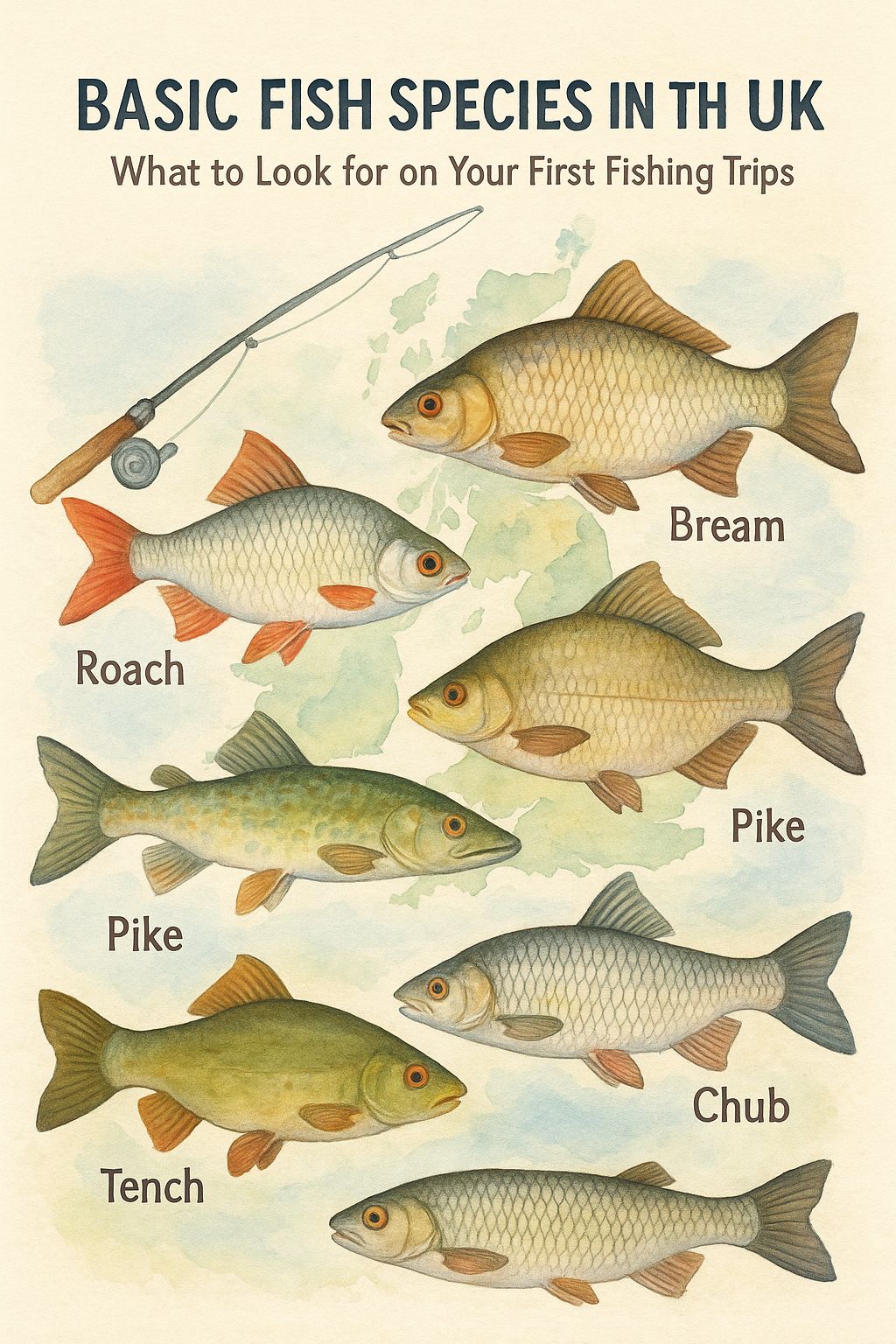As a newcomer to fishing in the United Kingdom, you’re about to embark on a rewarding journey into one of Britain’s most beloved pastimes. The UK’s waterways are home to a diverse range of fish species, each with unique characteristics, habitats, and behaviors. This guide will introduce you to the most common fish species you’re likely to encounter on your first fishing expeditions, along with practical tips for identifying and catching them.
Understanding Coarse Fishing in the UK
Before diving into specific species, it’s important to understand that most beginners start with “coarse fishing” – a term commonly used in the UK and Ireland. Coarse fishing refers to angling for freshwater fish that are not members of the salmon family (trout, salmon, char). While catch-and-release is popular in coarse fishing today, it’s not a legal requirement – many anglers do take some fish for consumption.
Fishing Licenses in the UK
The licensing requirements vary across the UK:
England and Wales: You need a “rod licence” if you’re 13 or older and fishing for freshwater fish (including trout, salmon, and eels). One license covers up to 2 rods. These can be purchased online from the Environment Agency via GOV.UK.
Scotland: There is no national “rod licence” requirement. Instead, fishing is regulated by local bylaws, and you often need to purchase a permit for specific fisheries.
Northern Ireland: Licenses are issued by DAERA (Department of Agriculture, Environment and Rural Affairs) and are divided into “game licences” (for salmon and trout) and “coarse licences” (for non-salmonid fish).
Always check local regulations before fishing, as specific waters may have additional rules and restrictions.
Common Carp (Cyprinus carpio)
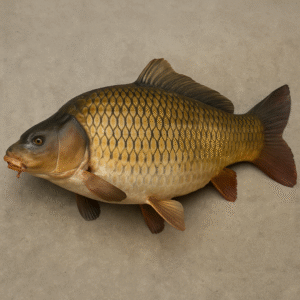
Identification: Common carp have a bronze to golden body color with large scales. They are deep-bodied fish with two pairs of barbels (four in total, whisker-like feelers) on each side of their mouth.
Habitat: Carp thrive in slow-moving waters like ponds, lakes, and canals, particularly around reed beds and areas with vegetation.
Size: Average weight ranges from 2-10 pounds (1-4.5kg), though specimen carp can grow much larger, with UK records exceeding 40 pounds (18kg).
Beginner Tips: Carp respond well to simple baits like sweetcorn, bread, and commercial pellets. They’re known for being “greedy” feeders and can provide an exciting experience for beginners, as they often put up a strong fight when hooked.
Roach (Rutilus rutilus)
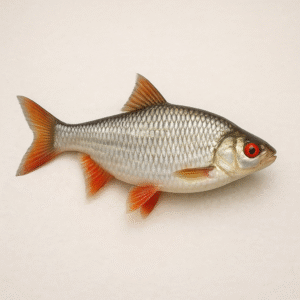
Identification: Roach have silvery bodies with distinctive bright red fins. They have a terminal mouth (straight, not downturned as sometimes described) and characteristic red eyes.
Habitat: Commonly found in large shoals in lakes, slow-moving rivers, and canals, often near bridges, reed beds, and areas with depth changes.
Size: Typically 4-12 ounces (100-350g), with specimen fish reaching over 2 pounds.
Beginner Tips: Roach are excellent targets for beginners as they’re abundant and respond well to simple baits like maggots, casters, and bread. Float fishing with light tackle is an effective approach.
Bream (Abramis brama)
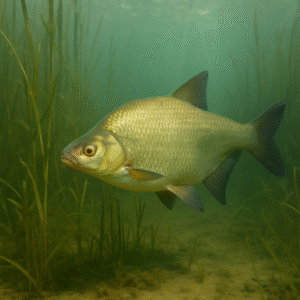
Identification: Bream have deep, flat-sided bodies with a bronze coloration. The anal and dorsal fins are typically reddish-white or dark. Their bodies are covered with protective slime.
Habitat: Prefer deeper, still waters with soft bottoms in lakes and slow-moving rivers.
Size: Commonly 1-4 pounds (0.5-1.8kg), with larger specimens reaching over 10 pounds.
Beginner Tips: Bream are bottom-feeders that respond well to worms, sweetcorn, and bread. They often gather in large shoals, so when you catch one, there are likely more nearby.
Perch (Perca fluviatilis)
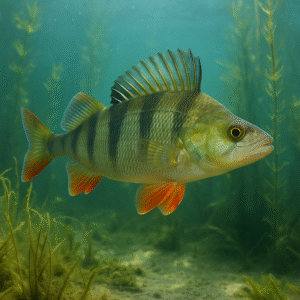
Identification: Perch are instantly recognizable by their green-brown body with distinctive dark vertical stripes and bright red/orange lower fins. They have a spiny dorsal fin that should be handled with care.
Habitat: Found in various waters from ponds to rivers and canals, often near structures like fallen trees, bridges, or weed beds.
Size: Typically 4-12 ounces (100-350g), with larger specimens reaching about 2.2 pounds (1kg). UK record specimens exceed 4 pounds.
Beginner Tips: Perch are predatory and can be caught using worms, maggots, or small lures. They’re active feeders that provide exciting sport, especially on light tackle.
Pike (Esox lucius)
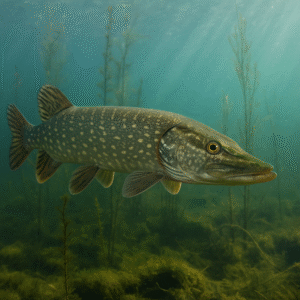
Identification: Pike have long, torpedo-shaped bodies with mottled green/brown coloration for camouflage. They possess a distinctive duck-bill-shaped mouth filled with sharp teeth.
Habitat: Found in lakes, slow-moving rivers, and canals, typically hiding among vegetation waiting to ambush prey.
Size: Common size range is 4-15 pounds (2-7kg), though specimens over 20 pounds (9kg) are not uncommon, with UK records exceeding 40 pounds.
Beginner Tips: Pike are predatory fish that require specialized tackle including wire traces to prevent bite-offs. While exciting to catch, they’re best approached after gaining some fishing experience due to their sharp teeth and specific handling requirements.
Tench (Tinca tinca)
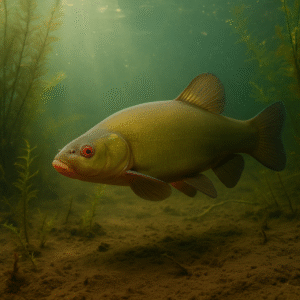
Identification: Tench have an olive-green to dark bronze coloration with small scales covered in a thick protective slime. They have red eyes and small barbels at the corners of their mouth.
Habitat: Prefer weedy ponds and lakes with soft, muddy bottoms where they can root around for food.
Size: Average 2-5 pounds (0.9-2.3kg), with larger specimens reaching over 10 pounds.
Beginner Tips: Tench are primarily active during warmer months (May to September). They respond well to worm baits, sweetcorn, and particularly to maggots. Early morning and evening fishing often yields the best results.
Chub (Squalius cephalus)
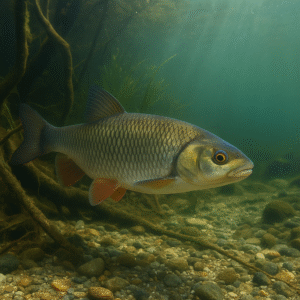
Identification: Chub have a torpedo-shaped body with a broad head, large scales, and a dark, rounded tail. Their coloration is typically bronze-green on the back with silvery sides.
Habitat: Primarily river fish, often found in flowing water near overhanging trees, bridges, and deeper pools.
Size: Commonly 1-4 pounds (0.5-2kg), with larger specimens reaching over 8 pounds (4kg).
Beginner Tips: Chub are less common in still waters but are a favorite river species. They respond well to a wide range of baits including bread, cheese, worms, and even small fruits like cherries.
Basic Tackle and Baits for First-Time Anglers
For your first fishing adventures targeting these species, here’s what you’ll need:
Essential Tackle:
A medium-action rod (10-12 feet for still waters, 8-10 feet for rivers)
A fixed-spool reel with 4-6 lb line (consider 6-10 lb line if targeting carp specifically)
Assortment of hooks (sizes 10-18)
Selection of floats
Split shot weights
Landing net
Disgorger for hook removal
Recommended Baits:
Maggots – Arguably the most versatile bait that almost all coarse fish will take
Sweetcorn – Excellent for carp, tench, bream, and many other species
Bread – Works well for surface fishing (crust) or rolled into balls (flake)
Worms – Particularly effective for perch, chub, and tench
Pellets – Commercial fishing pellets work well for carp and larger species
Fishing Techniques for Beginners
Float Fishing – The classic method where a float indicates when a fish takes the bait. It’s visual, exciting, and perfect for beginners.
Ledgering (Bottom Fishing) – Uses a weight to anchor your bait on the bottom, with bites detected by movements of the rod tip. Effective for bottom-feeding species like bream and carp.
Surface Fishing – Using floating baits like bread crust or dog biscuits (though bread flake is generally preferred over dog biscuits), particularly effective for carp in warm weather.
Tips for Success on Your First Trips
Research Your Venue – Different waters hold different species. Commercial fisheries are often well-stocked and ideal for beginners.
Start Simple – Focus on mastering basic techniques before trying more complex approaches.
Be Patient – Fishing requires patience. If you’re not getting bites, consider changing your location, bait, or depth.
Respect Fish Welfare – Wet your hands before handling fish, use a landing mat when appropriate, and return fish to the water carefully.
Observe Weather Conditions – Fish are more active in certain conditions. Overcast days with light winds are often ideal for beginner fishing.
Seasonal Considerations
Different species become more active at different times of the year:
Spring – Tench, bream, and roach begin feeding more actively as waters warm
Summer – Peak time for carp and most other species
Autumn – Pike become more active as water temperatures cool
Winter – Fishing becomes more challenging, but species like roach and perch can still be caught
In England and Wales, there is a statutory close season for coarse fishing on rivers and streams from March 15th to June 15th (inclusive) to protect spawning fish. This also applies to some protected still waters and canal sections, but most still waters remain open year-round.
In Scotland and Northern Ireland, there is no nationwide coarse fishing close season; instead, they have local bylaws with different dates and regulations.
Always check local regulations before fishing.
Conservation and Fishing Ethics
As a newcomer to fishing, it’s important to adopt responsible practices:
Use barbless hooks where possible for easier, less damaging hook removal and to minimize injury to the fish
Handle fish with wet hands and minimize time out of water
Never leave litter or discarded fishing line, which can harm wildlife
Respect other water users and wildlife
Use hook sizes appropriate to the target fish species to minimize potential injuries
Conclusion
The waters of the United Kingdom offer a wonderful variety of fish species for anglers of all experience levels. By starting with these common species and mastering the basics, you’ll build the foundation for many rewarding years of fishing. Remember that every angler started as a beginner, and patience is key to developing your skills.
Don’t be afraid to ask for advice from other anglers or local tackle shops – the fishing community is generally welcoming and happy to share knowledge. Most importantly, enjoy your time by the water, appreciate the natural environment, and celebrate every catch as you begin your fishing journey.
Tight lines and happy fishing!

